Auckland Transports public transport and cycling stats show that while November had one less weekday than it did in 2018, we saw still managed some decent growth in usage.
Public Transport
We should see a more detailed breakdown of the November numbers at the next AT board meeting in February but the high-level numbers are positive.
In total November saw 8.97 million boardings, up from 8.56 million the year before, a 4.8% increase. This also pushed us over 103 million boardings for the previous 12-months, up from 95.7 million the year earlier, a 7.7% increase.
A breakdown by mode is shown below with the busway still showing great growth. Positively even the ferries saw growth during the month following a number of poor results, for example in October even though there was an extra working day, usage dropped compared to 2018.
The growth in usage over the last year, much of it driven by the changes in the central and North Shore bus networks in 2018 is interesting because it also came after fares increased on average by 1.9% in February. AT said at the time they didn’t want to increase fares but had to to cover increasing costs. The board paper for the last increase suggested it would reduce annual trips by about 830,000. Some fares were later reduced, such as allowing children to be free with HOP on weekends.
The reason I raise this is any day now we should hear the outcome of the fare review for this year after it was sent to the AT board for a decision in December. One aspect that will almost certainly play a part is that farebox recovery, the amount of operational costs covered by passenger fares, has continued to decline in recent years. In October it was at 42.9% overall, down from 45.1% the year before.
And here is the other way of looking at it, the amount of subsidy we pay per passenger km travelled.
This data is a little out of date now but shows an approximate comparison with some cities in Australia, Canada and the US.
Cycling
Like with PT, the cycleway counters recorded some good growth in November which would have been helped by the month being generally warmer and drier than usual (it would have helped the PT numbers too).
Overall for the month AT say usage recorded on on their 26 city count sites was up 9.3% on November 2019 and some sites continue to see even stronger growth, such as Lightpath which was up 57% or the NW cycleway at Kingsland which was up 24%
We are likely heading for a record summer. For example the NW Cycleway at Kingsland in November almost matched the March peak number. Could the results in March get close to to that 45k upper limit?
Wellington Public Transport
Wellington’s ridership numbers were a bit rockier than those in Auckland. In total usage increased slightly however within that overall bus numbers were up slightly on what they had been. Rail on the other had was slightly down which would have reflected there being one less business day.
The graph below shows while total boardings are up, so to are unique (bus) journeys.
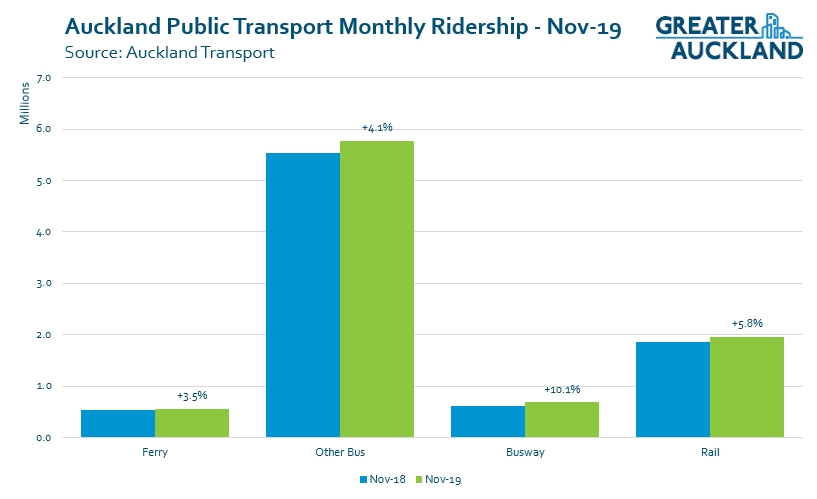
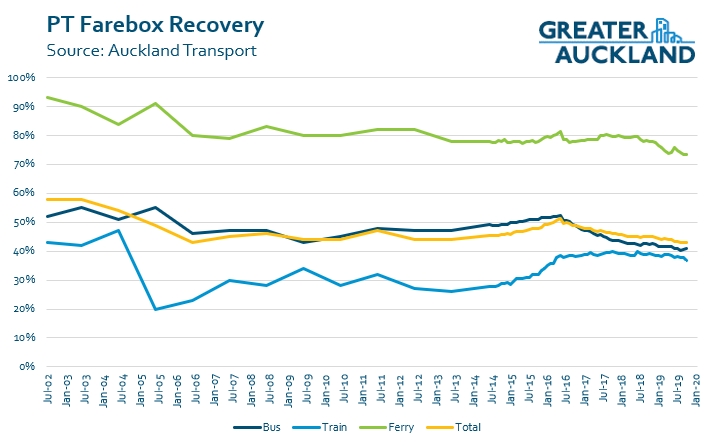
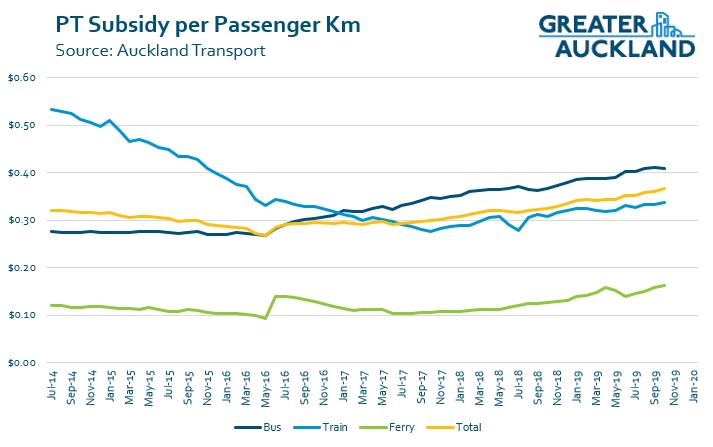
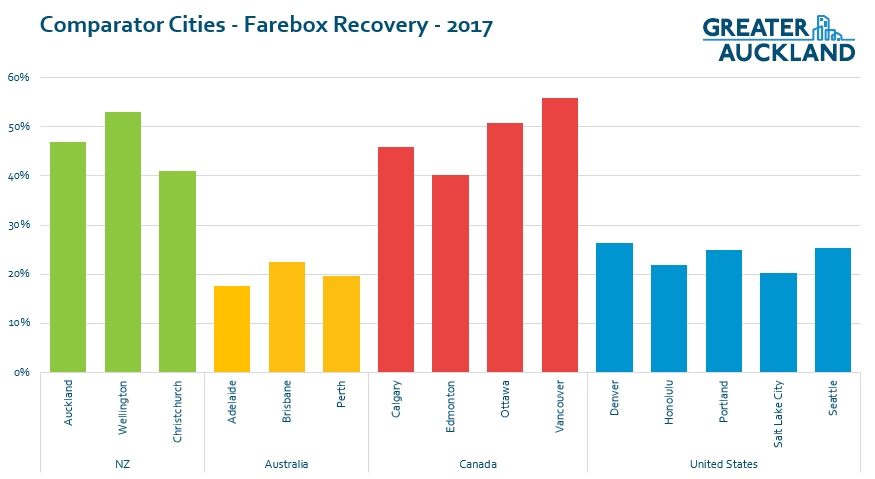
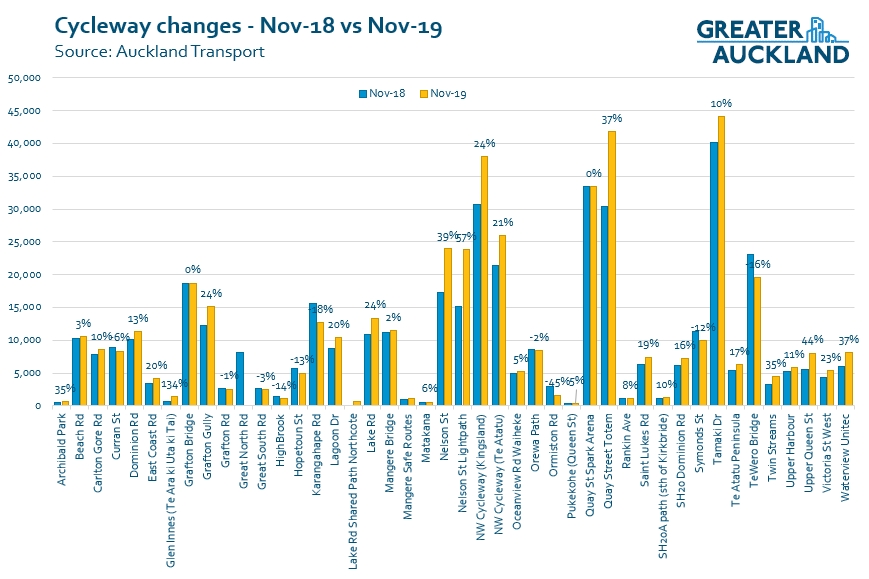
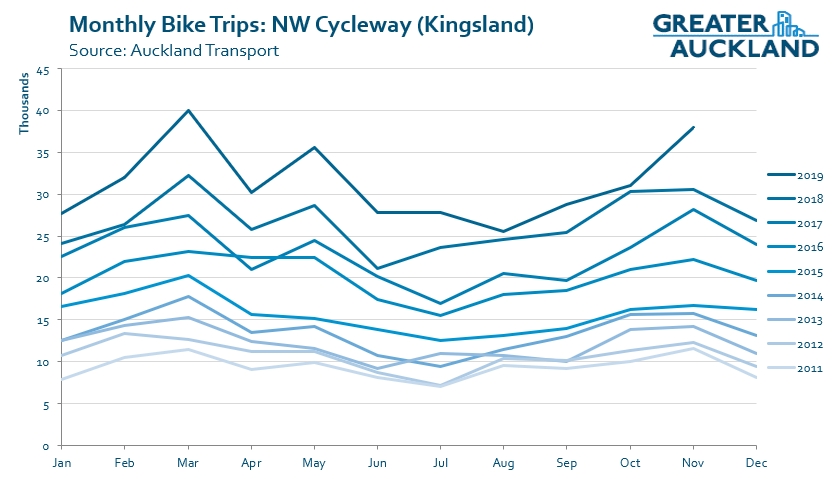
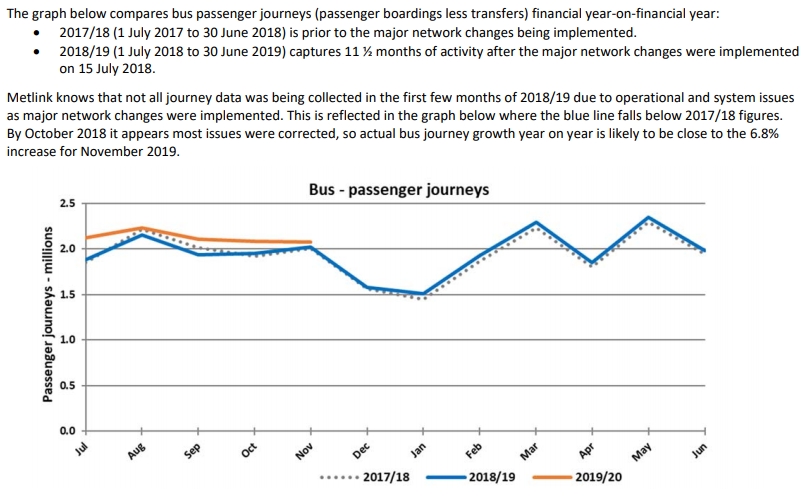

 Processing...
Processing...
Interesting that both Auckland and Wellington show the same pattern of a peak in March and May each year, but a dip in April. What is causing that? Something to do with School holidays?
On a different, completely un-connected matter, if I am coming from the Airport in Auckland and want to visit Hobsonville, I’d prefer to go by ferry. But the ferry timetable leaving from AKL CBD appears to show 2 early morning sailings and then nothing for hours – although the sailings continue regularly in the opposite direction. Where do the boats go to in the off-peak hours? They seem to have just disappeared off the map. What’s the best alternative means of public transport? – I don’t want to have to hire a car. I appreciate that it is an up and coming area, but it’s damn hard to get to!
Hey Guy,
Probably your best option is to take a northern express bus to Constellation. There is a connecting bus to Hobsonville from there.
Hello Guy,
If you are coming to Auckland what about giving me a ring on 478-7956 and maybe we can visit the architectural delights and otherwise of Hobsonville together. Think about it seriously!
Regards, Warren
Will do, thanks Warren !
The dip in April could be due to school holidays.
Could also be to worsening weather.
30 days in April, 31 in March and May?
Easter perhaps?
March and May seem to be sweetspots where all schools and tertiary institutions are in and few people take annual leave.
April on the other hand has school and university holidays and probably more people taking leave as a result of these and also Easter and Anzac often being good for extended breaks.
Yes it’s all designed for peak flow. It has been improved bit by bit with a weekend service now running at least.
If you really want to get a ferry & can’t make the earlier sailings, try the one to west Harbour, walk up to Wiseley Rd to catch a 112 bus across to Hobsonville. I’ve done that in reverse, walking through the Clearwater Cove Reserve & it’s quite a nice walk.
So I used too drive to the city as work paid for a carpark. I loved it, car with my own music, if I left late at least I would making my way there. When my work moved offices to Victoria park, we were told we were not going to have a car park and should use public transport. At that stage I was annoyed and grumpy of the thought of public transport and cost of $150+ per month was my major annoyance.
When we started, I still didn’t like it for the first month. After that I really started to see the benifits. Relaxing that you can look out the window, not worry about stop start in the traffic, that little walk did make me feel better, less stress, less times I was late to work compared to when I was in a car – could be up to 30 minutes late even though I took into account 50 min with traffic from Browns Bay to the city.
I think what government should do is there is no company initiative for using public transport. How did AT get all there staff to shift to public transport and cycling/walking to work. Maybe a section on the IRD site that says public transport scheme that you enter a per employee there AT hop card no, and they can sign up for half company pays and half employee pays? Is it something that government can encourage there employees to use public transport? When we implement a centralised equipment of hop around New Zealand, why can’t the government pay more than 50% if they are serious about getting citizens to use public transport.
Good insights Matt. In California there’s a law saying that major employers must provide their staff with the option to “cash out” any employer provided parking. This means you could have chosen to get paid a few hundred dollars more a month instead of getting a free carpark.
It’s perverse that you got free parking but have to pay for PT. Laws like California’s are critical to changing travel habits.
https://www.latimes.com/opinion/livable-city/la-ol-shoup-dtla-parking-cash-out-20170328-story.html
There is also the example of “Fare’s Fair”, the scheme implemented by Ken Livingstone in London back in the 80s – he slashed the cost of ALL public transport fares in London to 50% or less of their previous amount, in some cases as low as 20p per bus ride. Massively, massively successful, bringing vast amounts of people onto the buses and Tube. Main lesson to learn was: London Transport were not prepared for this success, and ran out of buses and space on Tube trains.
Then Thatcher came in and made it all illegal, removing subsidies, driving people back to their cars, and she also stopped investment / maintenance on the Tube. Result: chronic underinvestment and eventual almost collapse of the transport system, of which they are still catching up on.
Offer people decent incentives to cars and they will take them – but it will only work when the alternative to cars is cheaper, safer, faster and just as comfortable.
The lasting benefit of Fare’s Fair was not in the level of fares (which were ruled illegal under then-existing law – Thatcher made no changes at that time) but in its changes to the fare structure, introducing zonal fares that ultimately covered all rail operators and led to Oyster. That has fuelled London’s transport growth, just as AT Hop has in Auckland, and (fingers crossed) Project Next will do for the rest of the country.
If I remember correctly, carparks aren’t taxed whereas public transport funds are (fringe benefit tax). So the incentives are already put in place against public transport.
Someone double check me thanks
Yes Free parking at work and company cars are a distortion of travel behaviour via the tax system
https://www.nzta.govt.nz/resources/research/reports/474/
Richard
Thanks for that report. Given that it was written in 2012 it is a sad indictment on successive government’s lack of attempts to reduce emissions from employees’ vehicles.
FBT is payable if an employee is given a dedicated space for parking. If it is just a general parking area with no allocated spaces, no FBT is payable.
However, FBT would be payable on a PT pass if an employer helps pay for it.
AT should offer an annual pass so an employer could advance the money for it and then deduct an amount from each pay. Usually the annual pass is much cheaper.
This was big in Prague, where an annual pass was only $250 a year.
The annual pass is huge in Vienna – now over 700,000 per year.
I loved the PT system in Prague with seemingly trams going everywhere – at least where we visited.
Yes, I knew few people in Prague who didnt have one. No gates in Prague metro, just inspectors – so you just put it in your pocket and off you went.
It is the most used metro system in the world per capita, so they must be doing something right.
I have only visited Vienna, not lived there but it was a joy to use the system.
goosoid: I wonder if a pass/ticket system with inspectors would work out much cheaper than having the likes of fares and HOP and gates and the added boarding time, etc. Especially these days where you could buy a single ticket (2 hour or daily for example) on the AT app (if you didn’t have a month/year pass) and show the app to the inspector if needed.
I returned recently from a trip to Prague, Brno, Krakow and Warsaw. They all had wonderful tram/bus networks and relatively cheap and popular too. I didnt see a single ticket inspector over 3 weeks of using public transport.
An annual pass in Auckland would be great.
So much for all the angst about Wellington’s new bus network being a complete failure. There has been months and months of solid growth in ridership.
A few very vocal people getting far too much attention. I actually quite liked the new network.
It has been failure. Why do you think the GWRC is revamping the Wellington City segment of the regional bus network by re-introducing more direct services on core and secondary bus routes and eliminating the unpopular bus transfer hubs.
Was it the sort of failure that is still less of a failure than what they had before, then? Is that what we can read from the figures? I think quite a bit of improvement in PT have probably been in that sort of category.
Maybe they just need to improve the transfer hubs instead of going backwards.
It might need tweaking rather than going backwards.
I struggle a little with the situation in Wellington. Yes, it’s far from ideal and could have been managed better by all parties. I don’t think anyone disputes that. At the same time, bus patronage *is* growing, which suggests there’s some underlying merit to the changes.
The primary “failure” seems to be that the operator had insufficient drivers to deliver scheduled services, leading to cancellations. You might argue GWRC could have managed the operator more proactively, although I’m not sure that would have avoided the issue (given the driver shortage across New Zealand and Australia).
Many people do seem to be benefiting from other changes, such as increased frequency and span. The increase in ridership is impressive given the service cancellations mentioned above.
In terms of making further changes, in my view *all* networks should be constantly monitored and, where necessary, tweaked (and yes, this may include cutting services where they are an inefficient use of resources). That GWRC is considering further tweaks / enhancements to a new network is in some ways positive: They want to do better.
Of course, it perhaps would have been *even better* if they’d considered these issues more carefully initially (and possibly tipped in more money to ensure the network was implemented smoothly), although I say this with the benefit of hindsight.
Ultimately, it’s unfortunate people were disaffected and unhappy but, at the same time, it’s good that (1) ridership is now growing and (2) further improvements are being made.
Bittersweet, I guess?
The primary “failure” seems to be that the operator had insufficient drivers to deliver scheduled services, leading to cancellations”” – I’m afraid I beg to differ.
It’s important to appreciate that Wellington city has three bus operators, and different operators have provided very different experiences. As a vast over-simplification, those using Tranzurban (generally on the north-south axis) after a rocky start have seen brand-new buses, increased frequencies, and fewer forced transfers; those using Newlands (in the northern suburbs) have seen little change in timetables or routes, but better ticketing system and new buses; and those using NZ Bus (generally on an east-west axis) have seen reduced frequencies, introduction of forced transfers and introduction of older buses. The reasons for the variations are complex, but include the following (all identified at the time, but not acted on – no hindsight necessary!):
– the initial network design, consulted on in 2012, was objected to strongly by the northern suburbs (and largely accepted by others), and was extensively revised. In the 2014 final proposal (as implemented) the north was improved, with existing transfers removed, but as a balancing act service to the east was reduced, including the introduction of forced transfers and reductions in off-peak service of 50%. Since these changes were made as a result of consultation, they were not themselves consulted on.
– GWRC communications about the new network were relentlessly positive, creating the impression that everything would be better for everyone. (Overpromising and underdelivery are never a good combination.)
– a network relying on transfers needs to be reliable with good infrastructure, but GW made no bus priority proposals to WCC and made a complete hash of the new hubs – none of them were anything like complete at the time of the change, and the last two were completed just last month.
– the new contracts penalised unpunctuality and gave no incentives for making connections, so operators concentrated on the former and ignored the latter.
– Tranzurban and Newlands both introduced new fleets; NZ Bus continues to be dependent on ex-Auckland cast offs up to 15 years old (years older than the trolleys that they replaced), with no agreement on new buses yet in sight (they have some new doubledeckers, but because of low tunnels they cannot be used on the key east-west spine route).
Staff shortages added to these problems, but they would have existed even if the operators had been fully staffed.
So yes, there are a lot of people who like the new network, especially those with new buses, increased frequencies, service at weekends and in the evenings where they didn’t have it before, and where transfers have been removed. But for the parts of the city where NZ Bus is the operator, the opposite applies to all these measures (action is now being taken to address these).
It is ill-informed nonsense to say “A few very vocal people getting far too much attention”, as evidenced by GWRC’s Bus Network Review https://www.metlink.org.nz/on-our-way/bus-network-review/ (well worth a read) recognising the operational deficiencies and putting forward solutions; and by the many hundreds of people who turned out to public meetings on winter evenings to voice their concerns.
Progress is being made!
Mike M – that is a superb answer and as has been suggested before, you should be running the GWRC…! I think the only thing you didn’t mention, was that the “Bus Hubs” were a dismal failure, and that’s probably one of the reasons why Wellingtonians are whingeing.
I don’t know about you, but to me a Bus Hub would be something reasonably substantial, knowing that a number of people could potentially be changing buses there and could be waiting some time. If I was designing a Bus Hub, I’d put in seats for a start – heck, even walls and a roof – maybe some toilets, maybe even a little shop of some sort, or a tele to watch, something that conveys some vision of “service provision”. And I’d have it up and running well before the new network was implemented, especially considering that GWRC had 8 years to get it sorted. Eight years!! And what did they do when they finally launched their “bus hubs”? Nada, nothing, zip, zilch. Its just an ordinary bus stop, and it was late. No wonder people were livid…
Those are all good points, although I do think service cancellations are a big turn-off for passengers and there were a lot of them. Good to see other issues being addressed too.
Thanks, Guy! I agree with you about the bus hubs, poorly thought through, over both budget and time, and shortlived, too. Miramar ceases to have any scheduled connections in 10 days’ time, the hospital is planned to follow that later and similarly for Hutchison Rd, Newtown (the biggest hub of all, but for some reason called a “terminus” rather than a hub), with Brooklyn reduced to just two scheduled connections each hour. All except Hutchison Rd (to a limited extent) and Miramar will continue to be useful connection points between main routes, though.
And agreed, Stu – but the cancellations (NZ Bus’s being to a large extent self inflicted, since they made too many drivers redundant when they downsized) were essentially just the last straw, building on the ineptitude discussed in my earlier post.
Interesting to see an almost 5% increase in PT usage. I wonder what part of that is population growth and what is growth in patronage?
Do you think AT will publish station usage information again? I would be interested to see if the three Manurewa stations are underperforming in growth or not. (I find previous lack of passenger growth interesting given that Manurewa ward is one of the top five growth areas in Auckland. I wonder if it means that the current network does not meet the needs of the people living there).
Yes, those three will be interesting to watch. I’m not sure if you saw last year’s post with the station boardings, which showed strong growth for all three, which was good after the previous year’s results. All three retained their ranking in the rankings rug.
https://www.greaterauckland.org.nz/2019/09/11/2019-rail-station-boardings/
We probably need to track the boardings and compare them with the driving times and traffic counts on SH1.
“I wonder what part of that is population growth and what is growth in patronage.”
Or more importantly, is any of the growth other than due to an increase in population?
Whatever the answer is growth in ridership is not at a level to reduce carbon emissions quickly enough.
Population growth is no where near 5% and per capital usage has risen in last decade or so from about 45 to over 67. So yes Aucklanders are using PT more. But we need to be doing so a lot more
Matt
Perhaps I expressed my thoughts poorly.
“Population growth is no where near 5% and per capital usage has risen in last decade or so from about 45 to over 67” Neither of these facts, either singularly or together, tell us whether Auckland has reached a point of a maximum number of vehicles on the road; that is, the number of vehicles will decrease as car trips are replaced by those on PT.
Arguably “peak vehicles” should be a very important point because there should be no need for more roads/widening if we never anticipate them to be more busy than they are now. (If our local bodies were making rational decisions they would decrease road building/widening in advance of “peak vehicles” if that is what they are intending – no point building for non existent future demand.)
The increase in bus subsidies is interesting. Possible causes:
— Integrated fares
— PTOM bus reliability / punctuality KPIs
— Traffic congestion –> slower travel-times
Others?
Possible solutions: Charge for park-and-ride?
More buses running around virtually empty at midnight due to the new network changes??
All of the above I imagine. It shouldn’t have come as a surprise, but I imagine it is a much better investment than almost any other investment AT is making.
I recall on this site that PT capacity on the North Shore increased by 40% with the new network – that may well have increased costs.
Solutions? Stu, they are not hard to find and I agree with you regarding charging for park and ride.
What about an annual increase for all parking fees? When was the last time that some city parking buildings had a price increase – e.g. Victoria St? Where else can you find parking for $2 per hour?
Why is parking in some suburbs free?
Why is Sunday parking in some suburbs free?
It’s been confirmed in the last two weeks that the world has changed, perhaps irreversibly; when are our public entities going to respond to this?
Because these places are in competition with each other.
If parking somewhere costs money, you can just go somewhere else that doesn’t. Like a mall. Or not spending money at all, which is what a lot of people are doing, or having to do.
The medium term effects of climate change are very real, but so is a rational response in the short term. Why we expect businesses operating on wafer-thin margins to cope better with massive short term change than we expect the planet to is something I’ve never understood about the lack of perspective when it comes to climate change.
So an appropriately competition-aware parking response to the climate emergency is to keep skewing the market by subsidising drivers with free and cheap parking, in a chaotic, uncoordinated way? 🙂
Ah, you’re one of those guys. Problem is Buttwizard is that those medium term effects will be even bigger if we don’t start making drastic changes today…there won’t be those businesses you are so willing to protect if we don’t change now.
Climate change aside, why do other places around the world have Businesses which seem to thrive where free or subsidised parking isn’t offered. Why must the needs of many be hampered by the needs of a few who have had years and years to change their business models from a ‘a need parks outside my business to survive’ model.
Joe, well said.
I would add, why should we have confidence that the climate change problem is medium term? How large do the fires have to be in Australia before there is a real problem? Or droughts in East Africa?
On another theme – what is the point of a primary response to climate change of planting trees if, because of climate change, fires destroy them at a greater rate than they are planted.
Yes I’ve been wondering about that. There is a kiwi ecologist interviewed in this about 2:30 in who says that we need to be thinking about where the new NZ trees are planted and what species are used, recognising their different flammability.
https://www.rnz.co.nz/national/programmes/thepanel/audio/2018729842/australian-bushfires-rage
As ever, these statistics and their analysis are very interesting as a measure of boardings. But boardings are just one aspect of how well a network is performing, and don’t give a full picture of the value of the network, since short trips down Queen St or within the Golden Mile are counted the same as the lengthy ones from Pukekohe or Masterton.
Arguably a better indicator of the utility of the network is the number of passenger kilometres, a statistic that should be able to be derived pretty easily from AT Hop data (but with more difficulty in Wellington, with its Victorian – in the historical rather than geographical sense – train ticketing system. Does AT produce such data?
And this from AT today another fare increase from 9th Feb ;-
“Adult fares
Adult Cash fare (current) Cash fare from 9 February 2020 AT HOP fare (current) AT HOP fare from 9 February 2020
City Link $1.00 $1.00 $0.50 $0.55
1 zone $3.50 $3.50 $1.95 $2.00
2 zones $5.50 $5.50 $3.45 $3.55
3 zones $7.50 $7.50 $4.90 $5.00
4 zones $9.00 $9.00 $6.30 $6.40
5 zones $10.50 $10.50 $7.60 $7.60
6 zones – – $8.90 $8.80
7 zones – – $10.00 $10.00
8 zones – – $11.10 $11.10
9 zones – – $12.20 $12.20
Complete and utter disgrace! Auckland needs to desperately cut emissions and having 500k less PT trips is unhelpful.
Could JT have been right that the AT Board needs refreshing?